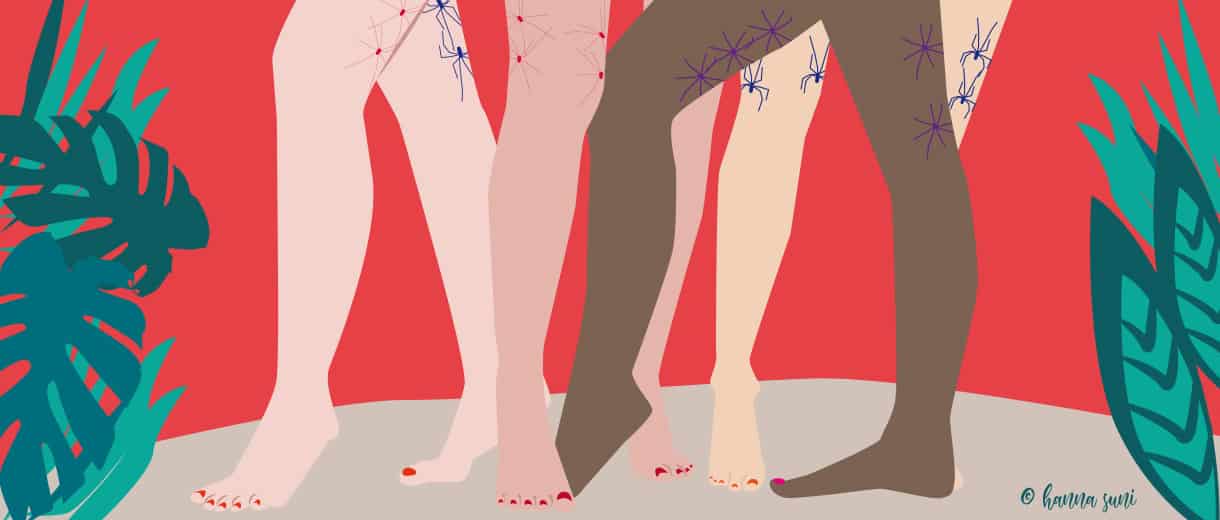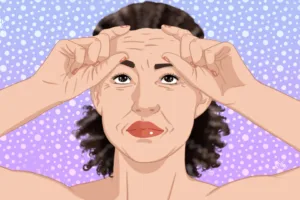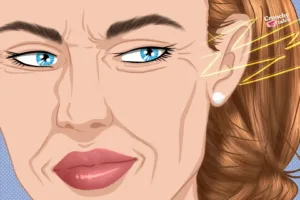Spider Attack: How To Get Rid Of Capillaries On The Legs
Subtle anti-aesthetic conditions are usual to appear on our body as we age. Spider veins are a rather common drag for middle-aged women, and you might have noticed those reddish hairlines appearing on the sides of your legs as you passed the 40 landmark. Even though the formation of spider veins is partly hereditary, there are some simple tips to follow and remedies you can use, in order to keep wearing those mini-skirts and shorts as proudly as before.
The cause of telangiectasia
“Spider veins – telangiectasia by their scientific name – are small, superficial veins that are in the outer layer of skin between the dermis and epidermis, so you can see them,” says Irina Poleva, MD, board-certified dermatologist. They are usually thin hairlines that may be flat or slightly raised on the surface of the skin. Red, blue, or purple-coloured, although they can cause some discomfort, they are normally rather painless. Less evident than varicose veins, spider veins may look like tree branches or spider webs and are usually found on the legs or the face.
According to the American Academy of Dermatologists (AAD), they form because of small insufficiencies in our blood flow. Our veins carry blood from the different parts of the body back to the heart and have small valves that act as one-way flaps in order for blood not to leak backwards. When these valves do not close properly, blood can leak back into the lower part of the vein rather than going toward the heart. Over time, more blood gets stuck in the veins, building pressure that weakens the walls of the veins, making them larger.
Not only a genetic nuisance
Spider veins are a problem that concerns especially women as they are twice as likely to suffer from the condition compared to men. Women who are in professions that involve many hours of standing up are even more likely to suffer from telangiectasia.
The main factor involved in this anti-aesthetic condition is the constitutional predisposition, our genes – explains Dr Poleva. However, there are many other factors that can trigger the appearance of spider veins: our hormonal status (the rise of female hormones during pregnancy as well as the decrease in menopause), our lifestyle (being over-weight, wearing tight trousers or high heels, smoking), regular intake of some medications (for example blood thinners or hormones), certain types of sport (such as weight lifting) and trauma on the legs.
Most women who suffer from spider veins do not have other physical symptoms related to them. However, some do experience restlessness and heaviness in their legs while others may feel a burning, throbbing, tingling sensation from time to time.
Self-care tips to prevent new spider veins from forming
Although spider veins sometimes appear regardless of our lifestyle, it is possible to act in the prevention of new ones from appearing. Here are some tips:
- Exercise regularly. Muscles in the legs help our veins push blood back to the heart, against the force of gravity. If you suffer from spider veins, any exercise – such as walking, running, jogging, swimming or bicycling – that works the muscles in your legs may help prevent new spider veins from forming.
- Avoid sitting or standing for too long a time. If your profession requires you to stand still or sit down for long hours, make an effort to take a break every 30 minutes to move around. This makes the muscles in your legs move the blood back up to your heart. Specialists from the Vein Clinics of America suggest setting an alarm on your phone to remind you to stand up or move around every now and then during the workday.
- Wear special compression stockings. These stockings apply a steady pressure to help move blood back towards your heart. The pressure also lessens swelling in your legs and reduces the risk of getting a blood clot.
- Lift your feet up at the end of the day. Lift your feet up on a stool or a chair as often as possible while sitting down. You can also lie on the ground and lift your legs up against a wall to enhance the venous return, moving and turning your ankles softly.
- Aim at losing weight, if you suffer from being overweight. Extra weight makes it more difficult for your veins to move blood back up to your heart. Losing weight may help prevent new spider veins from forming.
There are also other small adjustments to your lifestyle that might not only reduce spider vein formation but make you feel better overall.
To prevent the appearance of new spider veins and to slow down the worsening of existing ones, you need to act on all possible triggering factors – Dr Poleva suggests-. Use comfortable trousers instead of slim leg pants, comfortable shoes instead of high heels, stop smoking and do your best to avoid any trauma on your legs. It might also be useful to increase the intake of bioflavonoids through food supplements and enrich your diet with fruits and vegetables: red fruits, red onion, cabbage, grapefruit and tea all include bioflavonoids.
Professional treatment options
If your condition is truly bothersome, you can also turn to a specialist – either an angiologist or a dermatologist – for professional treatment options.
The most used methods are sclerotherapy and vascular laser treatments – Dr. Poleva tells-. The former includes injections of solutions that close the enlarged capillaries. The latter targets red colour and heats selectively the red or blue capillaries, leaving the surrounding skin practically untouched.
According to AAD, sclerotherapy is a commonly used and safe method where anaesthesia is not needed. It is advisable to use compression stockings after the treatment. The same goes for laser treatment, after which is it also necessary to stay out of the sun for a few weeks. Although these treatments are rather efficient, telangiectasia has a high rate of recurrence.
Like this post? Sign up to our newsletter to get more articles like this delivered straight to your inbox.





